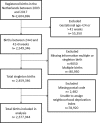Persisting inequalities in birth outcomes related to neighbourhood deprivation
- PMID: 31685540
- PMCID: PMC7035720
- DOI: 10.1136/jech-2019-213162
Persisting inequalities in birth outcomes related to neighbourhood deprivation
Abstract
Introduction: Health inequalities can be observed in early life as unfavourable birth outcomes. Evidence indicates that neighbourhood socioeconomic circumstances influence health. However, studies looking into temporal trends in inequalities in birth outcomes including neighbourhood socioeconomic conditions are scarce. The aim of this work was to study how inequalities in three different key birth outcomes have changed over time across different strata of neighbourhood deprivation.
Methods: Nationwide time trends ecological study with area-level deprivation in quintiles as exposure. The study population consisted of registered singleton births in the Netherlands 2003-2017 between 24 and 41 weeks of gestation. Outcomes used were perinatal mortality, premature birth and small for gestational age (SGA). Absolute rates for all birth outcomes were calculated per deprivation quintile. Time trends in birth outcomes were examined using logistic regression models. To investigate relative inequalities, rate ratios for all outcomes were calculated per deprivation quintile.
Results: The prevalence of all unfavourable birth outcomes decreased over time: from 7.2 to 4.1 per 1000 births for perinatal mortality, from 61.8 to 55.6 for premature birth, and from 121.9 to 109.2 for SGA. Inequalities in all birth outcomes have decreased in absolute terms, and the decline was largest in the most deprived quintile. Time trend analyses confirmed the overall decreasing time trends for all outcomes, which were significantly steeper for the most deprived quintile. In relative terms however, inequalities remained fairly constant.
Conclusion: In absolute terms, inequalities in birth outcomes by neighbourhood deprivation in the Netherlands decreased between 2003 and 2017. However, relative inequalities remained persistent.
Keywords: birth weight; health inequalities; perinatal.
© Author(s) (or their employer(s)) 2020. Re-use permitted under CC BY-NC. No commercial re-use. See rights and permissions. Published by BMJ.
Conflict of interest statement
Competing interests: None declared.
Figures



Comment in
-
Neighbourhood deprivation and perinatal health in the Netherlands.J Epidemiol Community Health. 2020 Mar;74(3):209-210. doi: 10.1136/jech-2019-213460. Epub 2019 Dec 16. J Epidemiol Community Health. 2020. PMID: 31844030 No abstract available.
Similar articles
-
Decreasing trend in preterm birth and perinatal mortality, do disparities also decline?BMC Public Health. 2020 May 26;20(1):783. doi: 10.1186/s12889-020-08925-w. BMC Public Health. 2020. PMID: 32456627 Free PMC article.
-
Individual accumulation of heterogeneous risks explains perinatal inequalities within deprived neighbourhoods.Eur J Epidemiol. 2011 Feb;26(2):165-80. doi: 10.1007/s10654-010-9542-5. Epub 2011 Jan 4. Eur J Epidemiol. 2011. PMID: 21203801 Free PMC article.
-
Ability of municipality-level deprivation indices to capture social inequalities in perinatal health in France: A nationwide study using preterm birth and small for gestational age to illustrate their relevance.BMC Public Health. 2022 May 9;22(1):919. doi: 10.1186/s12889-022-13246-1. BMC Public Health. 2022. PMID: 35534845 Free PMC article.
-
A Scoping Review of Socioeconomic Inequalities in Distributions of Birth Outcomes: Through a Conceptual and Methodological Lens.Matern Child Health J. 2020 Feb;24(2):144-152. doi: 10.1007/s10995-019-02838-w. Matern Child Health J. 2020. PMID: 31894509
-
COVID-19 mortality and deprivation: pandemic, syndemic, and endemic health inequalities.Lancet Public Health. 2022 Nov;7(11):e966-e975. doi: 10.1016/S2468-2667(22)00223-7. Lancet Public Health. 2022. PMID: 36334610 Free PMC article. Review.
Cited by
-
Can an Ecological Index of Deprivation Be Used at the Country Level? The Case of the French Version of the European Deprivation Index (F-EDI).Int J Environ Res Public Health. 2022 Feb 17;19(4):2311. doi: 10.3390/ijerph19042311. Int J Environ Res Public Health. 2022. PMID: 35206501 Free PMC article.
-
Neighborhood socioeconomic inequality and sarcopenia in community-dwelling older adults: a cross-sectional study.Ann Med. 2025 Dec;57(1):2534085. doi: 10.1080/07853890.2025.2534085. Epub 2025 Jul 25. Ann Med. 2025. PMID: 40708378 Free PMC article.
-
Analysis of association between low birth weight and socioeconomic deprivation level in Japan: an ecological study using nationwide municipal data.Matern Health Neonatol Perinatol. 2022 Oct 6;8(1):8. doi: 10.1186/s40748-022-00143-z. Matern Health Neonatol Perinatol. 2022. PMID: 36203206 Free PMC article.
-
Examining modification of the associations between air pollution and birth outcomes by neighborhood deprivation in a North Carolina birth cohort, 2011-2015.Front Reprod Health. 2024 Jul 11;6:1304749. doi: 10.3389/frph.2024.1304749. eCollection 2024. Front Reprod Health. 2024. PMID: 39055124 Free PMC article.
-
Impact of COVID-19 mitigation measures on the incidence of preterm birth: a national quasi-experimental study.Lancet Public Health. 2020 Nov;5(11):e604-e611. doi: 10.1016/S2468-2667(20)30223-1. Epub 2020 Oct 14. Lancet Public Health. 2020. PMID: 33065022 Free PMC article.
References
-
- Black RE. Global prevalence of small for gestational age births : Low-Birthweight baby: born too soon or too small. Karger Publishers, 2015: 1–7. - PubMed
-
- World Health Organization Commission on the Social Determinants of Health Closing the gap: policy into practice on social determinants of health: discussion paper 2011.
Publication types
MeSH terms
LinkOut - more resources
Full Text Sources
Medical
